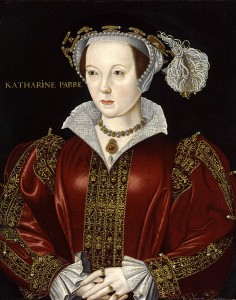 On 12th July 1543, Henry VIII married Catherine Parr, Lady Latimer, in the Queen’s Closet at Hampton Court Palace. This was Henry VIII’s sixth and final marriage and Catherine was also not new to marriage, having been married and widowed twice before, firstly to Edward Burgh (or Borough), son of Sir Thomas Burgh and grandson of Edward, 2nd Baron Burgh, and secondly to John Neville, 3rd Baron Latimer of Snape in Yorkshire. Latimer had died in March 1543. The King was not Catherine’s final marriage, she went on to to marry Thomas Seymour, Baron Sudeley, in 1547.
On 12th July 1543, Henry VIII married Catherine Parr, Lady Latimer, in the Queen’s Closet at Hampton Court Palace. This was Henry VIII’s sixth and final marriage and Catherine was also not new to marriage, having been married and widowed twice before, firstly to Edward Burgh (or Borough), son of Sir Thomas Burgh and grandson of Edward, 2nd Baron Burgh, and secondly to John Neville, 3rd Baron Latimer of Snape in Yorkshire. Latimer had died in March 1543. The King was not Catherine’s final marriage, she went on to to marry Thomas Seymour, Baron Sudeley, in 1547.
The marriage ceremony was performed by Stephen Gardiner, Bishop of Winchester, and was attended by around twenty courtiers and friends. Catherine’s supporters at the ceremony included her sister, Anne Herbert; Henry VIII’s daughters, Mary and Elizabeth; Henry’s niece, Lady Margaret Douglas; Anne Stanhope, the Countess of Hertford; Catherine Willoughby, the Duchess of Suffolk; and Jane Dudley, Viscountess Lisle and wife of John Dudley. The men included Catherine’s brother-in-law, William Herbert; Anthony Denny; Sir Thomas Speke; Sir Edward Baynton; Sir Richard Long; Sir Thomas Darcy; Sir Henry Knyvet; Sir Thomas Heneage; Edward Seymour, Earl of Hertford; John, Lord Russell, the Lord Privy Seal, and Sir Anthony Browne, Captain of the King’s Pensioners.
The marriage is recorded in several primary sources. Chronicler Edward Hall simply writes “In this yere, the Kyng maryed Ladye Katherin Par wydow, late wyfe to the Lorde Latymer, at Hampton Court”,1 and Charles Wriothesley, chronicler and Windsor Herald, writes “This yeare, the 12 of Julye, Lady Katharine, late wyfe of the Lord Latimer, lately departed, and sister of the Lord Parre, was proclaymed Quene and marryed to the Kinges Majestye at Hampton Courte.”2 The notarial attestation in Letters and Papers, by Richard Watkins, gives details of the ceremony:
“Notarial instrument witnessing that, on 12 July 1543, 35 Hen. VIII., in an upper oratory called “the Quynes Pryevey closet” within the honor of Hampton Court, Westm. dioc., in presence of the noble and gentle persons named at the foot of this instrument and of me, Ric. Watkins, the King’s prothonotary, the King and lady Katharine Latymer alias Parr being met there for the purpose of solemnising matrimony between them, Stephen bp. of Winchester proclaimed in English (speech given in Latin) that they were met to join in marriage the said King and Lady Katharine, and if anyone knew any impediment thereto he should declare it. The licence for the marriage without publication of banns, sealed by Thos. abp. of Canterbury and dated 10 July 1543, being then brought in, and none opposing but all applauding the marriage, the said bp. of Winchester put the questions (recited) to which the King, hilari vultu, replied “Yea” and the lady Katharine also replied that it was her wish; and then the King taking her right hand, repeated after the Bishop the words, “I, Henry, take thee, Katharine, to my wedded wife, to have and to hold from this day forward, for better for worse, for richer for poorer, in sickness and in health, till death us depart, and thereto I plight thee my troth.” Then, releasing and again clasping hands, the lady Katharine likewise said “I, Katharine, take thee Henry to my wedded husband, to have and to hold from this day forward, for better for worse, for richer for poorer, in sickness and in health, to be bonayr and buxome in bed and at board, till death us depart, and thereto I plight unto thee my troth.” The putting on of the wedding ring and proffer of gold and silver (described) followed; and the Bishop, after prayer, pronounced a benediction. The King then commanded the prothonotary to make a public instrument of the premises.”3
The wedding was followed by a celebration breakfast and a proclamation that Catherine was now Queen.
You can read more about Catherine Parr in the following articles:
- Was Katherine Parr a feminist?
- 25 April 1544 – Queen Catherine Parr’s first work is published
- The Catherine Parr Bio page
- Catherine Parr – The Old Nursemaid?
- Catherine Parr in Danger, an article by Elizabeth Norton
- Last But Not Least: The Enduring Fascination of Catherine Parr, an article by Linda Porter
- Catherine Parr – The One Who Got Away
- The Death of Catherine Parr
- The Mystery of Mary Seymour Solved?
- 30 August 1548 – Catherine Parr, Queen Dowager, Gives Birth to a Daughter
Also on this day in history…
- 1537 – Execution of Robert Aske, lawyer and rebel. He was hanged in chains outside Clifford’s Tower, the keep of York Castle. Aske was one of the leaders of the rebels in the 1536 northern uprising known as the Pilgrimage of Grace.
Notes and Sources
- Hall, Edward. Hall’s Chronicle, p. 858.
- Wriothesley, Charles. A chronicle of England during the reigns of the Tudors, from A.D. 1485 to 1559: Volume 1, p. 143.
- LP xviii. i. 873.